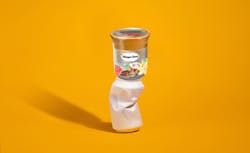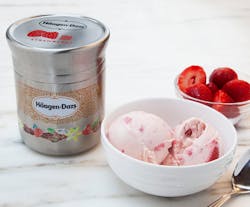While there’s no scientific evidence to support this claim, there’s a widely shared consensus that most people eat ice cream directly out of the container. While a seemingly unimportant detail in the production of this popular dessert, for Nestlé, it was one of the most critical considerations as it planned out a new, radical design for its Häagen-Dazs ice cream brand.
In January of 2019, Nestlé announced a partnership with TerraCycle, a global recycling organization that was rolling out a first-of-its-kind home delivery service called Loop.
TerraCycle, known for its mission to eliminate waste by creating new products from the collection of hard-to-recycle materials, has been around for two decades. Last year, during the World Economic Forum in Davos, Switzerland, TerraCycle founder Tom Szaky unveiled Loop, a shopping platform that will enable people to consume products in customized, brand-specific, durable packaging that is collected, cleaned, and refilled.
As the world shines a spotlight on sustainability initiatives that factor in recycling single-use packaging, Loop takes the eco-friendly, green model to the next level by introducing reusable containers. And some of the biggest food and beverage and consumer package goods (CPG) companies including Unilever, Procter & Gamble, Clorox, Mars, Coca-Cola, PepsiCo, Nestlé, and more, were onboard for the pilot program that launched last year.
For its part, Nestlé joined Loop as it committed to expanding its global efforts to develop new packaging designs that minimize the impact on the environment, noting that by 2025 the company plans to make 100% of its packaging recyclable or reusable. As part of the Loop pilot program, Häagen-Dazs ice cream was delivered in a reusable, stainless-steel, double-walled ice cream container, which keeps product fresh and cold while maintaining the pint at a comfortable temperature for the person eating the ice cream straight from the container. The design also enables the ice cream to melt quicker at the top, and its rounded edges means the last spoonful doesn’t get stuck in the corners of the container.
“The package design process was a critical part of the entire Loop process,” said Steve Yeh, a project manager at Häagen-Dazs. “It’s not just about making a reusable container, it’s also about creating a high-touch consumer experience.” According to Yeh, the Häagen-Dazs package went through a total of 15 iterations before it finally launched. “Nestlé committed major resources to design and develop the original package.” The team also worked closely with Loop on developing breakthrough cooling technology for the Loop Tote, which the ice cream container is delivered in via UPS.
Terracycle officials admit there is a cost to manufacturing partners committing to Loop—from the investment in new durable packaging to the design of the product to the time spent understanding how to handle new packaging lines and how to scale to meet demand. But the reality today is that sustainability efforts are here to stay. And any new endeavor is going to require an upfront investment.
According to a new business intelligence report from PMMI, the Association for Packaging and Processing Technologies (and Automation World parent company), packaging sustainability has moved beyond a trend and is now a global shift. Released in March 2020, the report, “Packaging Sustainability: A Changing Landscape,” reveals how sustainable packaging initiatives at CPGs are affecting machines, materials, and packaging formats. The report states that the global sustainable packaging market reported that total value of revenue was estimated at $220 billion in 2018 and is predicted to reach $280 billion in 2025, growing at a compound annual growth rate of approximately 6%.
The report is based on information collected from 100 sources and 60 interviews. The majority of the CPGs interviewed are looking to switch to lighter weight, recyclable, and sustainable materials to reduce waste. About 36% of the CPGs interviewed are exploring the circular model of reuse/return/refill.
The circular economy
For decades consumers have been participating in the “throwaway lifestyle,” where single-use products are disposed of resulting in massive amounts of waste. According to the Environmental Protection Agency, the total generation of municipal solid waste (MSW) in 2017 was 267.8 million tons or 4.51 pounds per person per day. Of the MSW generated, more than 94 million tons of MSW were recycled and composted, equivalent to a 35.2% recycling and composting rate. In other words, we don’t have a good track record for recycling. TerraCycle thought there must be another way—which is Loop.
“The genesis of Loop is a tighter, closed-loop system that has manufacturers taking back ownership of their packaging,” said Ben Weir, Loops’ business development manager for North America. “It’s bringing about the reusability of packaging in something that is durable and long-lasting and that can be cleaned and used hundreds of times.”
It’s not a new concept, but rather a throwback to the milkman model in which consumers returned the glass containers. What’s new is the aesthetic benefits that will drive consumer brand perception—and, while not obvious at first—it is a better economic model for the manufacturer.
“The concept of a circular economy is an economic model, not a sustainability framework,” said Tim Debus, president and CEO of the Reusable Packaging Association (RPA). “By decoupling growth from the consumption of finite resources, maintaining product values at their highest, and building market resilience to source material disruptions. It is estimated that the circular economy offers $4.5 trillion of value from new growth and innovation opportunities, and the world today is only 8.6% circular.”
There is an enormous opportunity, but manufacturers may hesitate due to the upfront investment related to packaging design and retooling machinery.
According to Nestlé’s Yeh, the company used its Bakersfield, Calif., facility to ramp up its production of ice cream in reusable and durable containers for the Loop pilot project. “We decided to retrofit an existing line to support the platform versus investing in a new line. It was not an easy changeover and required some reengineering. Some of the changes involved installing more modern equipment including better code daters and more modern metal detection.”
Yeh said they also incorporated improvements to existing processes, which requires additional staff to handle the containers. “Once the platform expands, we would then visit a fully automated system.”
Automating the Loop
The Loop circular platform works like this: Consumers buy a product online through the Loop store or at a retail location—Nestlé will offer Loop containers in more than 200 Häagen-Dazs shops across the U.S. this year, and Kroger and Walgreens have partnered with Loop to offer products in retail stores later this year. The customer pays a small, fully refundable one-time deposit to “borrow” the package. The delivery is then scheduled online when the customer checks out and pays for shipping to have the Loop Tote filled with product delivered, via UPS, to the customer’s doorstep. When the containers are empty, the consumer puts it back into the Loop Tote and schedules a pick-up. The containers are sent to a Loop facility to be cleaned using state-of-the art cleaning technology and are then sent back to the manufacturer to be refilled. If a consumer purchases ice cream through the Loop subscription, for example, Nestlé fills the sanitized steel container in its Bakersfield, Calif., facility and ships it back to TerraCycle to fulfill the e-commerce orders.
Loop is operating the entire supply chain to ease the burden on partners, Weir said, but right now the circular Loop is a largely manual process. “There is tremendous opportunity for technology advancements to be made whether it is IoT (Internet of Things) or [other] levels of traceability in the system, there is definitely opportunity there,” he said.
RPA’s Debus agreed, noting that the ability to put some kind of tracking technology on an individual package could become a vehicle for inventory management (where the product is), predictive analytics (when the container will come back), and monitoring for quality control, traceability, and recall capabilities.
A lot of the tracking technology available today, such as RFID tags, are outfitted on large pallets or containers used in transporting products, but there are new offerings available now that provide real-time visibility of returnable assets without building out an RFID infrastructure.
Roambee, for example, provides an “infrastructure-less sensing platform,” called the Honeycomb IoT Application Programming Interface (API) Platform, that uses Bluetooth, a cellular network, or ultra-low power radios to send data directly to the cloud where it can be analyzed. Of course, it may not make sense to equip every container of Häagen-Dazs with a sensor, and that doesn’t have to happen.
“We don’t do 100% tagging, but we do 100% extrapolation of data,” said Vidya Subramanian, Roambee co-founder and vice president of products, noting that it does not have to be a sensor. The tracking method could be as simple as a QR code. “Location helps derive context. If it’s at a cleaning facility you can extrapolate that location to action, like it is available for filling. We take location and assign context to it.”
The Honeycomb platform does three things: drive compliance of expected action, drive performance in terms of velocity and movement, and keeps the brand secure—making sure that the product has not been compromised in the chain of custody.
Preparing the packaging line
Of course, before CPGs can even think about tracking containers, they must first think about switching over lines to accommodate new kinds of packaging—be it durable goods or light-weight materials.
According to Rich Carpenter, general manager of product development at Emerson Automation Solutions, three things have to come together to enable trouble-free line changeovers. “The manufacturer has to buy in to modular manufacturing and demand it from their suppliers. The control suppliers have to embrace plug-and-play technology so that when the system arrives on site it can easily plug into whatever automation is there be it PLC [programmable logic controller], SCADA [supervisory control and data acquisition], or DCS [distributed control system]. And the OEM has to make equipment in a way that is more reconfigurable and easier to do product changeovers so as needs change the equipment can adapt to it.”
These things are starting to converge, and, as PMMI’s Packaging Sustainability report points out, there is a real opportunity for machine builders to be proactive now to help manufacturers meet their sustainability packaging goals.
Loop is one option for manufacturers trying to make good on sustainability promises. And it seems to be catching on. “We’ve moved from 25 global brands to 150 global brands in a year’s time,” Weir said. “And the idea of an elevated offering is resonating with the consumer.”
Manufacturers, too, are thinking about how Loop can be applied upstream, as well.
“Working with TerraCycle has challenged our way of thinking across the board,” Nestlé’s Yeh said. “We are currently exploring new avenues to reduce our own single-use packaging across our supply chain. For example, we’re working more closely with our suppliers to receive our ice cream ingredients in reusable containers.”
About the Author
Stephanie Neil
Editor-in-Chief, OEM Magazine

Leaders relevant to this article:




